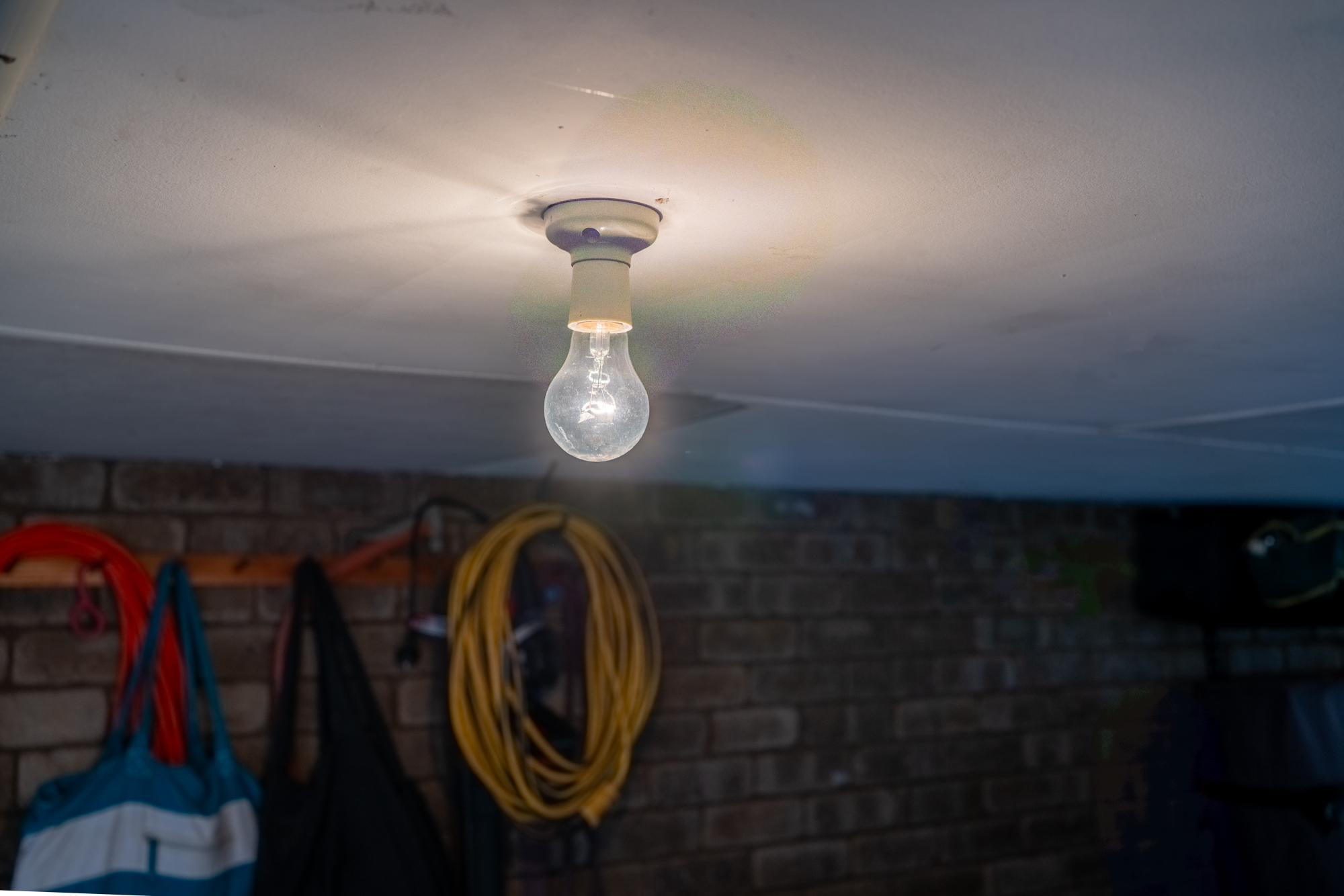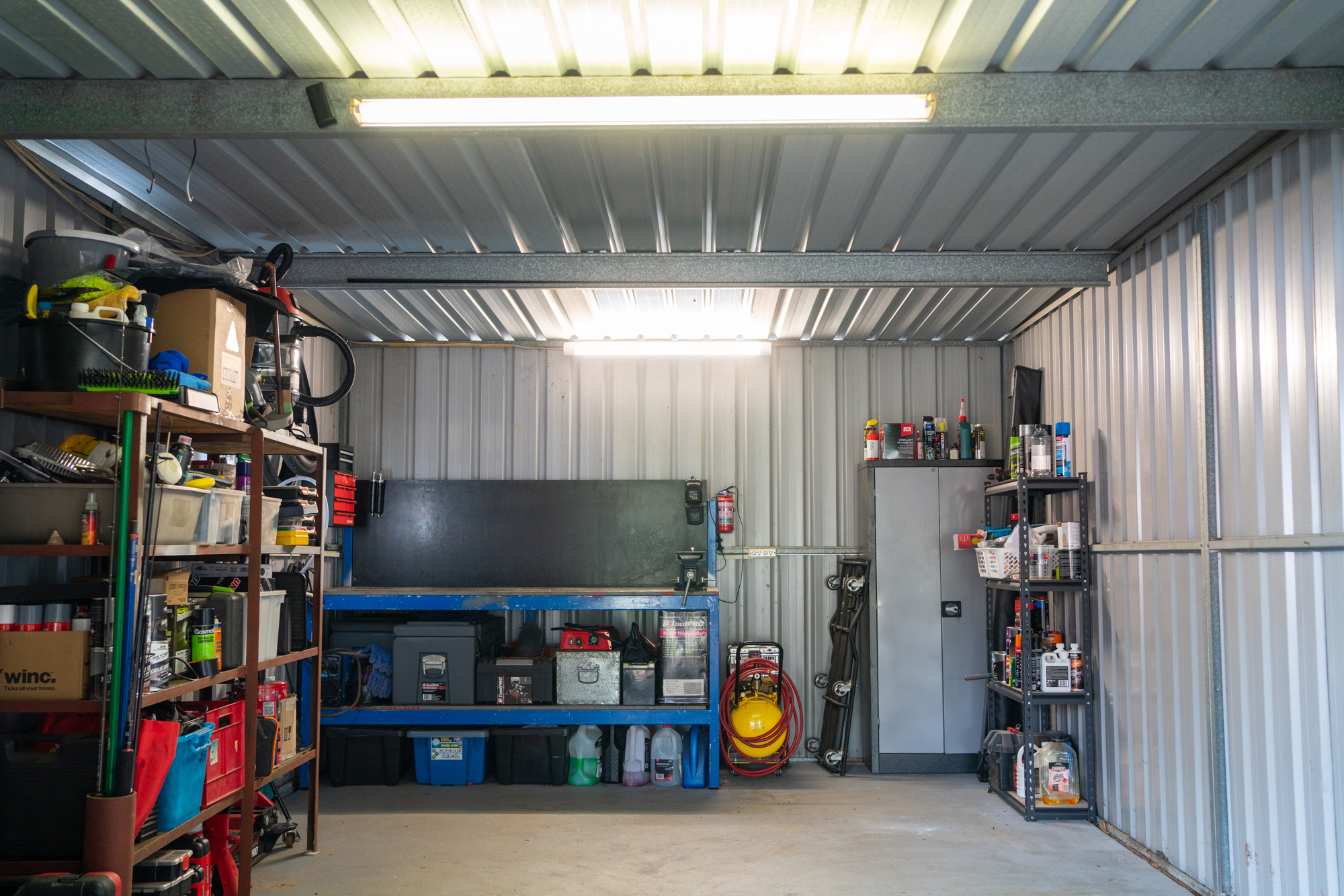The Ultimate Guide To Garage and Workshop Lighting
Overview
A little thought put into garage lighting can make your shed a much nicer place to be. There are many garage lighting ideas to consider. From lighting a whole workshop, to lighting for workbench areas, to a portable workshop light for working in tight spaces. So, let’s ‘shed’ some light on shed lights.

An introduction to garage lighting
Garage lighting can be one of three very different technologies. Incandescent, fluorescent, and LED (light emitting diode). Let’s take a quick look at each type to determine which will be the best shed lighting for you.
Incandescent & Halogen lighting
Incandescent lighting, also known as halogen lighting, is that old warm glowing light bulb you may be familiar with, the common household light bulb. These are the oldest and least efficient type of light, with the shortest lifespan and are being phased out worldwide. Aside from occasionally illuminating a workbench they are not the best choice today. If you still have some incandescent lights around the place; there are brighter and more efficient LED replacements that will drop right in.

Fluorescent Lighting
Fluorescent lights are commonly recognised as long tubes, though they can sometimes be found in a light bulb format similar to an incandescent bulb. Fluorescent tubes have long been the choice for lighting a whole garage or workshop as they are brighter, whiter, longer lasting, and use far less energy than incandescent bulbs. Fluorescent tubes run much cooler and can be designed quite compact, hence they were widely used in portable work lights. However, since they are quite fragile; LED is the new preference for work light formats.
Today they are still the best bang for buck as ceiling lights in your garage or shed, although this will likely change in the near future.

LED Lighting
Light Emitting Diodes (LEDs) are compact, bright, SUPER energy efficient, and they last practically forever. There’s no fragile glass bulb, so bumps and knocks are not a worry. With no bulb to ever require replacement, LED lights can be built resistant to splashes or even totally waterproof. They don’t get hot either, so it’s no surprise they are the industry standard for handheld, portable and head torch work lights.
Of course there’s a catch. LEDs are expensive compared to fluorescent lights, and their output is more directional, which means you’ll need to invest in a greater number to achieve even light over a broad area.


What are watts? Using watts to choose garage lighting
A watt is simply the measure of how much power something uses. You’ll find it listed on most appliances and lights around the home. Put two different watt lights of the same type side by side, and the higher watt light will always be brighter and use more power.
Put an incandescent, fluorescent, and LED light side by side though; and watts becomes irrelevant. A fluorescent light will usually be brighter than an incandescent light of the same watts, and LED will be MUCH brighter than a fluorescent light of the same watts.
How to choose garage lighting with lumens
Lumens is the measure of how much visible (to the human eye) light is generated by a light. You’ll usually find this advertised on packaging somewhere. The higher the lumens, the brighter the light. Put an incandescent, fluorescent, and LED light of the same lumens next to each other; and each will be the same brightness as the next.
Types of garage lighting
There are three main types of light you’ll want in a garage, workshop, or shed as follows:- Area lighting – this is to generally illuminate the entire space
- Task lighting – this is the more directional light you would typically use at a workbench
- Portable lighting – this can be work lights, under bonnet lights, torches, and head torches
Let’s break down some further use cases and the type of lighting best suited to each.
Area Lighting
Area lighting is installed as high as possible on the roof or ceiling for maximum coverage and reduction of shadows. When planning how many lumens for garage lighting, work on around 500 lumens per square metre, more for roofs higher than around 3 metres. Fluorescent garage lighting is a great choice for this with its wide, bright, even spread and good energy efficiency.
LED is also an option, but to achieve the same even spread of light you’ll need to plan the same number of lumens across a greater number of lights. This is to combat the directional nature of LEDs and reduce shadows.
Task Lighting
Task lighting will be installed above your workbench, tool boxes, shelving, or any other corner you need more light. Your task lighting can be more direct as shadows won’t be such a problem. Since you won’t be moving them around, you can save some money buying mains powered lights and never have to worry about them going flat. Fluorescent, incandescent and LED lights all make great task lighting.
Portable lighting
Today’s portable lighting is almost exclusively battery powered. Some, like the under-bonnet work light; will remain in place for the duration of the job. Others are designed to be moved around more and have a combination of magnets and hooks to position them while you work. You will probably want a few portable lights for different situations. Larger ones can be brighter, small ones are dimmer but can shed light in tighter and trickier places.

The best garage lighting for each job
Now that you’re familiar with the three broad garage lighting types, let’s talk about some of the most common lights and why they are garage favourites.
What is the best type of lighting for car repairs?
1. Headlamps
A headlight or headlamp is great because it moves with your head. These work lights can make working underneath
vehicles far easier and can usually be tweaked to suit the task at hand with different brightness settings.
Headlamps are also great for camping, hiking, hunting or anywhere you move about a lot. They are SUPER handy
kept in your glovebox or toolkit, along with a few spare batteries, in case of emergencies.
2. Worklights
These work lights are designed to
illuminate a specific work area such as under the bonnet, inside a wheel arch
or underneath the car. They usually take the form of a long light, sometimes hinged from the main body and
sometimes fixed. They can also include a smaller single LED on the tip for super tight spaces. An inspection
light will usually incorporate magnets and hooks for versatile hands free use.
3. Hand Held Torches
A simple ‘must have’ type of worklight is the good old hand held torch. In fact, you really should have a
number
of them stashed throughout the car, home and shed. A good LED torch is tiny and powerful, and can also be impact
resistant, waterproof, and resistant to oil and other fluids. As you know, torches are made to be handheld so
you won’t often find hooks and magnets, but it is perfect to keep in your pocket ready for a quick inspection or
venture beyond the garage lights.
4. Inspection lights
Inspection lights are for close inspection of dark and hard to reach spots under a car or in the depths of the
engine bay. This means they are usually built as small as possible to shine light in the trickiest spaces.
Sometimes a flexible goose neck separates the large handle from a tiny LED, and some models even include
inspection mirrors and claw pick up tools.
What is the best lighting for a workbench?
1. Mountable Work Lights
The same work light that you’d use for working on the car is also handy at the workbench. With its magnets and
hooks it can easily be positioned to provide the best lighting for workbench areas. Choose a model that is 240v
mains powered, or if you’re seeking a rechargeable work light; try to find one which can remain charged while
simultaneously being powered off the mains.
2. Fixed Lighting
Depending on your workbench setup, a fluorescent or LED strip light or lamp fixed above the work area with
screws or bolts will provide strong, consistent lighting for many a tinkering session. So long as your workbench
is situated near a power point to supply it; fixed lighting is great for a workbench.
3. Floodlights & Lamps
Floodlights and flood lamps are often
used in temporary workshop spaces or when lighting is required outside,
though they are also useful for brightening up areas of a workshop where the overhead lights cast too much
shadow. These were once most commonly halogen, though now LED technology has very much taken over.
Safe Lighting Practices
Let’s start with the basics, don’t look directly at a light source. It’s not a bright idea. In some cases even reflected light can be too hard on the eyes, so consider grabbing something dimmer, or choose a light with variable settings.
If you are still using incandescent work lights, the risk of burns and fire is very real. You’ll need to use extra caution when spraying paint or working with any flammable substances. With LEDs, the risk of burns and fire is almost a non-issue. However, large LED work lights can get warm and especially hot around the heat sink (if one is equipped).
Finally, electricity and fluids. We all know they don’t play nicely together. Whenever your job involves fluids, try to use only battery operated work lights and choose a waterproof model.

FAQs
How many lumens should garage lights have?
Lighting your garage or shed properly can be an expensive exercise. Fortunately, there is a loose formula to help you decide how many lumens for garage lighting so that you don’t blow your budget. Around 500 lumens per square meter should cover it, but allow a little more if the ceiling in your garage or shed is higher than about 3 metres.
How much light do I need in my garage?
To make sure you have enough light in your garage, you should cover three main areas.- Area lighting – This is lighting to illuminate your entire garage or shed space, usually it will be ceiling lights
- Task lighting – This lighting illuminates specific areas of your space, such as the work bench
- Portable lighting – This illuminates a smaller area again, and can include head lamps, torches, work lights, and inspection lights.
Which lighting colours are best for my garage?
Choosing the colours for your garage lighting is not just a matter of taste. Lighting is measured in Kelvin (shown by the letter K after a number). The higher the number, the cooler the light. Lighting around 5500K is close to daylight. A lower number like 3000K is warmer in colour and pleasing to the eye, but less bright than 7000k which is very cool, very bright, and quite clinical.
*Important information* - Click here to read more about our DIY Advice Terms and Conditions.